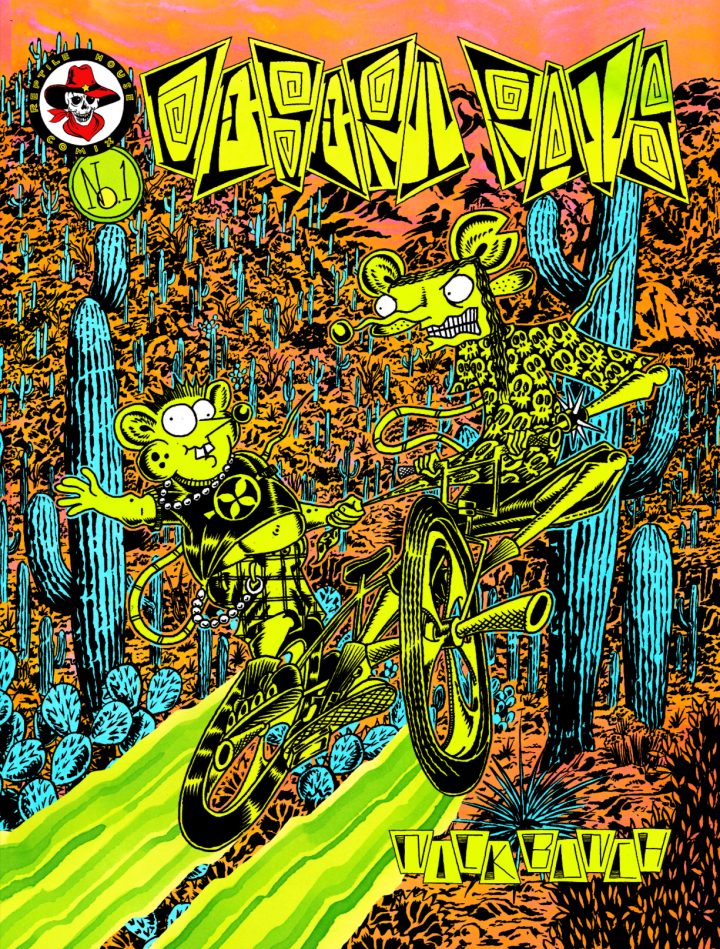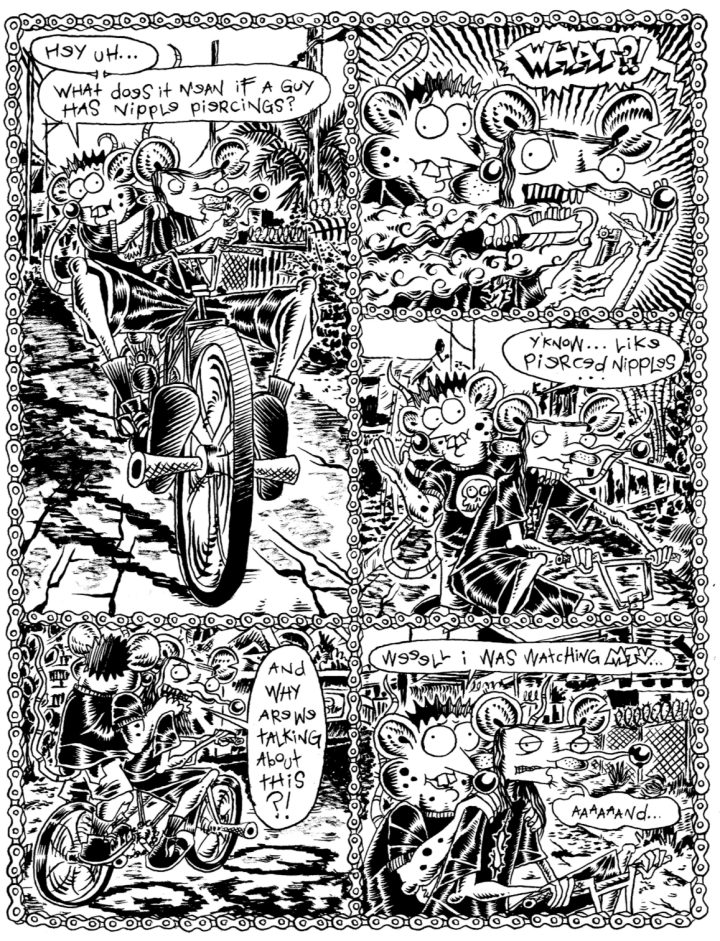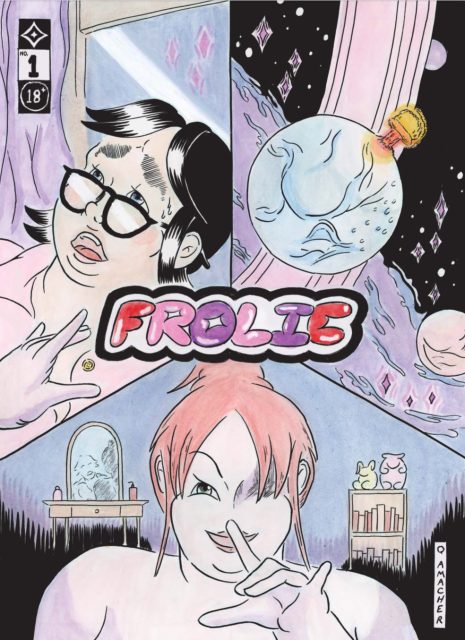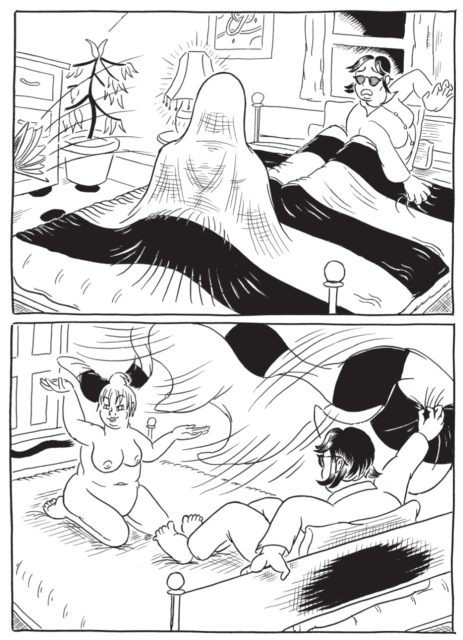What makes a comic transgressive? From the undergrounds of the 60s and the alternatives of the 90s, many conflicting visions of what it is to transgress rear their ugly, beautiful heads. Transgression may be an aesthetic, from the disobedient stylings of Fort Thunder to the fantastic psychedelia of fort thunder. It may be a commitment to obscenity, like Robert Crumb at his least palatable or Rory Hayes at his being Rory Hayes. Perhaps all of that is bullshit and transgression is a political ethic – I would certainly hold the opinion that Wimmen’s Comix was a far more transgressive project than Zap, although one would be hard pressed to bill Trina Robbins an outsider artist. Maybe transgression is simply dubious legality, being sold in a head shop, banned by a library, slipping by a censor. Usually, “transgressive” means many things at once. Transgression is neither a quality nor a virtue yet invites a moral and aesthetic discourse – which comic is more transgressive, Boiled Angels or Gender Queer? Consider two new independent comics which wave the banner of transgression in completely different registers – Nick Bunch’s Desert Rats #1 recalls a retro grungy aesthetic of transgression in a bold act of cartooning, while Quinn Amacher’s Frolic #1 arrives at transgression by way of political undercurrents and a sexual obscenity. Would you rather read about wiping out or eating shit?

Desert Rats collects Nick Bunch's recurring gag series from the comix anthology Reptile House about the misadventures of two punkish rat boys who seem to have oozed out of a hazy recollection of MTV's Liquid Television block. There's a skinny tall rat who is mean and a short fat rat who is dim-witted. I have no idea if they have names. These rats crash through convenience stores and head shops and zip across wide open roads and bustling city streets, generally bickering and contemplating meaningless bullshit while cooking up hazy schemes and making life hell for any normal person who crosses their path.
I've read a bit of Reptile House, and I liked Bunch's comics, but I would not have seen his work as terribly special before revisiting these stories in this collection. The difference comes down to dimensions — Desert Rats is printed much larger than the 8.5x5.5 Desert Island, and gives the scraggly ink drenched noise of Bunch's vibrant cartooning some much needed room to breathe. Bunch's compositions are maximalist, noisy, full of fat and detail, balanced out by an economy of movement that keeps his pages animated, actions accentuated by the slashing of marks on the page and the arrangement of panels. Bunch's rats are emotional creatures, radiating their frustrations and desires. Even the sound effects are vivid, three dimensional pieces that take on the shape of noises and clatter across the frame like so much debris. That Bunch's art remains noisy at their reprinted scale offers them a staying power beyond an anthology feature — the sheer craft behind the noise is both evident and satisfying.

Bunch has a knack for comedy on the comics page — his dialogue is razor sharp, his slapstick is visceral, and he never neglects to make faces funny. His storytelling, however, does not always reach the same height as his artistry. Bunch is at his best with the Desert Rats when they are bouncing off each other and the chaos left in their wake is a backdrop. In the collection's best story, the tall rat bikes across town while growing increasingly furious about the small rat, who clings to his back and babbles incoherently about nipple piercings. The strip is visually sumptuous, panel borders framed by bicycle chains in a stunning compositional fluorish, but the star here is the banter and the pair's expressions, the mounting contrast of the small rat's lazy eyed obliviousness to the tall rat's mounting road rage, culminating in some downright Tashlinesque physical comedy. Where Bunch fumbles is populating the rest of his rat world. Every supporting character in Bunch's world is both a straight man and a furious oaf, always already extremely pissed off at the rat duo and totally silly to such a degree that there cannot really be any escalation. Everyone in Bunch's world is obviously just as dumb and awful as his rats, leaving an overall tone not of satire or transgression but slack jawed cynicism. The first story in the collection, wherein the rats harass and terrorize a homeless man, left a particularly ugly taste in my mouth. I doubt that Bunch's cartoon bum reflects any real deep-seated hatred for the unhoused, but it certainly reflects the consequences of a creative incuriosity that embraces the aesthetics of attitude without the bite of transgression. Bunch's parodies are types, no different from the debris of a cartoon explosion. Something remains to be desired in Bunch's comics, something that I think he can reach in future work — he is already a furious cartoonist with a fully formed voice, lacking nothing more and nothing less than a good reason to scream.

Quinn Amacher does not deal in the style of transgression but rather its substance. Her comics are assertively queer and anarchist in their politics, angry in that way only a storyteller who loves people can be. Amacher's debut graphic novel, Syncing, envisioned the day-to-day struggles of communal life in the wake of environmental devastation. Frolic #1 is the self published first issue of Amacher's one-woman anthology, a duet of two short pieces, a sex fantasy and a science fiction allegory. The sex fantasy, “Puh-cest,” is straightforwardly transgressive in the blunt manner that many taboo fetishes can be — a trans woman's farts are possessed by a ghost, who eats the woman's shit until she can finally be set free. The second story “Rad Moon”, depicts a sentient moon of Saturn infested by an invading human population. The two stories share a certain sense of hope for the future — the ghost freed from bondage via scat play drifts joyously past earth's atmosphere, the plagued moon finds solace in the arrival of human children, who play and do not fight amid the man-made pollution of her surface. Both stories chart relief from suffering, freedom to play, and the transgression of imagining life after violence free from judgment.
Amacher's linework is elegant and her use of gray tones deft and evocative. Her figures, however vary in confidence. Amacher is commendably observant in her depiction of fat bodies and at times a canny artist of physicality, but there is an undeniable stiffness which occasionally still shows itself in her figures and especially her expressions -- characters often look as though they are constantly pressing their heads against glass. This is a bit of an issue for a comic which is mostly comprised of a long sex scene, where how bodies move and how sensitive feelings are expressed *is* the story.

Nonetheless, I see Amacher pushing herself in this comic — the environmental flourishes of “Rad Moon” play to her strengths of her cartooning, while “Puh-cest” presses on her weaknesses. In many panels, I can see Amacher testing her abilities, drawing difficult poses and expressions with a range of angles and techniques, building up the dimensions of her cartoon bodies, her growth is evident on the page, as pleasing to see as her fat femme ghosts literal shit eating grin. These are the works of an artist building herself up to a more confident, mature period of cartooning, one which I look forward to following.
In writing this column, I have set up a dichotomy which implies that Frolic is the “real” transgressive comic, while Desert Rats is only superficially transgressive. However, this is not my honest conclusion. Transgression is circumstantial. It may be a moral or artistic choice, but it is one that can only exist in relation to cultural norms, norms which an artist resists but rarely chooses. Both Desert Rats and Frolic are proudly independent works of comic-making that defy commerce. In the world we inhabit today, despite their wild differences and starkly contrasting merits and weaknesses, the culture at large is no more willing to accept stupid jokes drawn incredibly well than trans women enjoying scat. Bunch and Amacher are both resisting the dominant paradigm, in wildly different modes and to wildly different ends, and they are both really talented, driven cartoonists whose work’s excitement surpasses rough edges. From comix to comics and back again, maybe the best transgression we cartoonists have to offer is our willingness to make our own goddamn funnybooks and share them with the world.
The post Uncertain Transgressions appeared first on The Comics Journal.

No comments:
Post a Comment